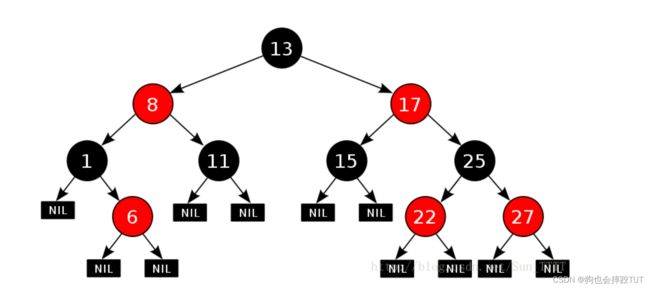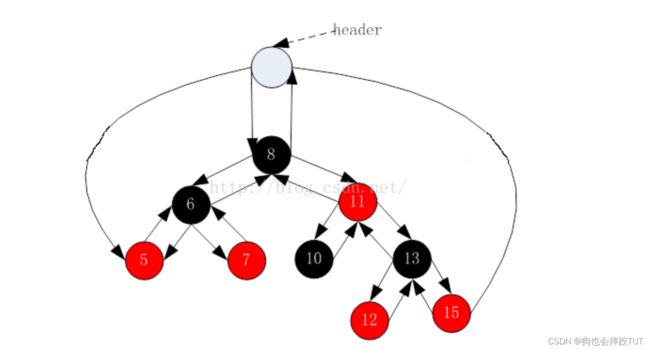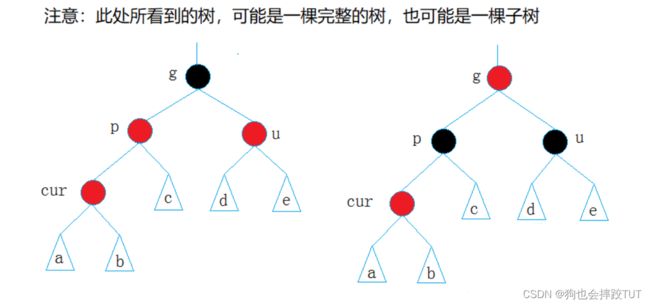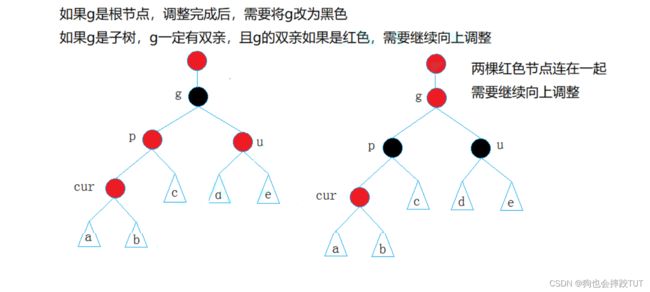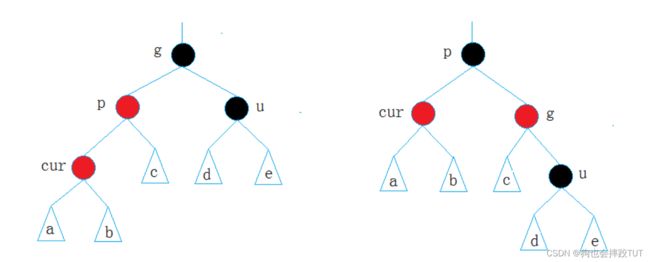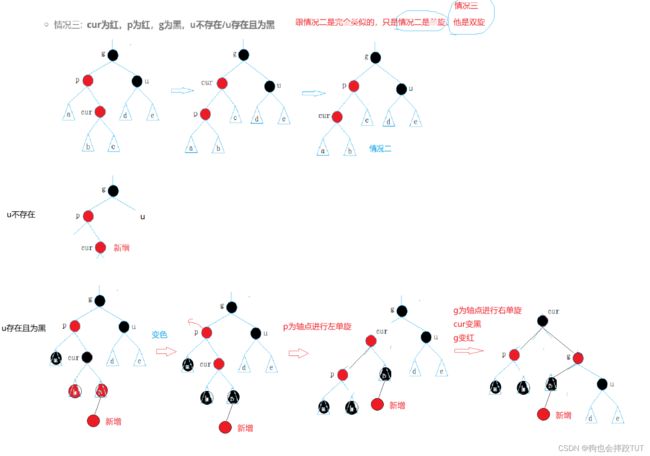【C++】红黑树

文章目录
- 红黑树的概念
- 红黑树的性质
- 红黑树的节点定义
- 红黑树的结构
- 红黑树的插入操作
- 红黑树的验证
- 红黑树删除
- 红黑树模拟实现STL中的map与set
- 改造红黑树
- map的模拟实现
- set的模拟实现
红黑树的概念
红黑树,是一种二叉搜索树,但在每个结点上增加一个存储位表示结点的颜色,可以是Red或
Black。 通过对任何一条从根到叶子的路径上各个结点着色方式的限制,红黑树确保没有一条路
径会比其他路径长出俩倍,因而是接近平衡的。
红黑树的性质
- 每个结点不是红色就是黑色
- 根节点是黑色的
- 如果一个节点是红色的,则它的两个孩子结点是黑色的
- 对于每个结点,从该结点到其所有后代叶结点的简单路径上,均 包含相同数目的黑色结点
- 每个叶子结点都是黑色的(此处的叶子结点指的是空结点)
红黑树的节点定义
enum class Colour : unsigned int//class是用来限制类型的
{
RED,
BLACK
};
template<class T>
struct RBTreeNode
{
RBTreeNode<T>* _left;
RBTreeNode<T>* _right;
RBTreeNode<T>* _parent;
T _data;
Colour _col;
RBTreeNode(const T& data)
:_left(nullptr)
, _right(nullptr)
, _parent(nullptr)
, _data(data)
, _col(Colour::RED)
{}
};
这里是将眼色默认设定成为红色,原因是在上述写的红黑树的性质中有两条的内容是这样写的,不能连续出现红节点,和每条路径下的黑节点数量必须相同。在两者必须要违反一种的情况下选择了前者。前者的代价要比后者的代价小得多。
红黑树的结构
为了后续实现关联式容器简单,红黑树的实现中增加一个头结点,因为跟节点必须为黑色,为了
与根节点进行区分,将头结点给成黑色,并且让头结点的 pParent 域指向红黑树的根节点,pLeft
域指向红黑树中最小的节点,_pRight域指向红黑树中最大的节点,如下:
上述的结构式STL源码当中的结构,而我接下来要写的不是上述的结构。
红黑树的插入操作
红黑树是在二叉搜索树的基础上加上其平衡限制条件,因此红黑树的插入可分为两步:
1. 按照二叉搜索的树规则插入新节点
if (_root == nullptr)
{
_root = new Node(data);
_root->_col = Colour::BLACK;
return make_pair(itertor(_root), true);
}
Node* parent = nullptr;
Node* cur = _root;
KeyofValue kov;
while (cur)
{
if (kov(cur->_data) < kov(data))
{
parent = cur;
cur = cur->_right;
}
else if (kov(cur->_data) > kov(data))
{
parent = cur;
cur = cur->_left;
}
else
{
return make_pair(itertor(cur), false);
}
}
cur = new Node(data);
Node* newnode = cur;
if (kov(parent->_data) > kov(data))
{
parent->_left = cur;
}
else
{
parent->_right = cur;
}
cur->_parent = parent;
上面的代码是第一步,为了找到插入节点属于他的位置。就是二叉搜索树的结构。
2、检测新节点插入后,红黑树的性质是否造到破坏
while (parent && parent->_col == Colour::RED)
{
Node* grandfather = parent->_parent;
if (parent == grandfather->_left)
{
Node* uncle = grandfather->_right;
if (uncle && uncle->_col == Colour::RED)
{
// 情况1:u存在且为红,变色处理,并继续往上处理
parent->_col = Colour::BLACK;
uncle->_col = Colour::BLACK;
grandfather->_col = Colour::RED;
cur = grandfather;
parent = cur->_parent;
}
else
{
// 情况2+3:u不存在/u存在且为黑,旋转+变色
// g
// p u
// c
if (cur == parent->_left)
{
RotateR(grandfather);
parent->_col = Colour::BLACK;
grandfather->_col = Colour::RED;
}
else
{
// g
// p u
// c
RotateL(parent);
RotateR(grandfather);
cur->_col = Colour::BLACK;
grandfather->_col = Colour::RED;
}
break;//旋转了就可以退出了
}
}
else // (grandfather->_right == parent)
{
// g
// u p
// c
Node* uncle = grandfather->_left;
// 情况1:u存在且为红,变色处理,并继续往上处理
if (uncle && uncle->_col == Colour::RED)
{
parent->_col = Colour::BLACK;
uncle->_col = Colour::BLACK;
grandfather->_col = Colour::RED;
// 继续往上调整
cur = grandfather;
parent = cur->_parent;
}
else // 情况2+3:u不存在/u存在且为黑,旋转+变色
{
// g
// u p
// c
if (cur == parent->_right)
{
RotateL(grandfather);
grandfather->_col = Colour::RED;
parent->_col = Colour::BLACK;
}
else
{
// g
// u p
// c
RotateR(parent);
RotateL(grandfather);
cur->_col = Colour::BLACK;
grandfather->_col = Colour::RED;
}
break;
}
}
}
_root->_col = Colour::BLACK;
return make_pair(itertor(newnode), true);
因为新节点的默认颜色是红色,因此:如果其双亲节点的颜色是黑色,没有违反红黑树任何
性质,则不需要调整;但当新插入节点的双亲节点颜色为红色时,就违反了性质三不能有连
在一起的红色节点,此时需要对红黑树分情况来讨论:
约定:cur为当前节点,p为父节点,g为祖父节点,u为叔叔节点
红黑树的验证
红黑树的检测分为两步:
- 检测其是否满足二叉搜索树(中序遍历是否为有序序列)
- 检测其是否满足红黑树的性质
bool IsBalance()
{
if (_root && _root->_col == Colour::RED)
{
cout << "根节点颜色是红色" << endl;
return false;
}
int benchmark = 0;
Node* cur = _root;
while (cur)
{
if (cur->_col == Colour::BLACK)
++benchmark;
cur = cur->_left;
}
// 连续红色节点
return _Check(_root, 0, benchmark);
}
bool _Check(Node* root, int blackNum, int benchmark)
{
if (root == nullptr)
{
if (benchmark != blackNum)
{
cout << "某条路径黑色节点的数量不相等" << endl;
return false;
}
return true;
}
if (root->_col == Colour::BLACK)
{
++blackNum;
}
if (root->_col == Colour::RED
&& root->_parent
&& root->_parent->_col == Colour::RED)
{
cout << "存在连续的红色节点" << endl;
return false;
}
return _Check(root->_left, blackNum, benchmark)
&& _Check(root->_right, blackNum, benchmark);
}
红黑树删除
传送门
红黑树模拟实现STL中的map与set
begin()与end()
STL明确规定,begin()与end()代表的是一段前闭后开的区间,而对红黑树进行中序遍历后,
可以得到一个有序的序列,因此:begin()可以放在红黑树中最小节点(即最左侧节点)的位
置,end()放在最大节点(最右侧节点)的下一个位置,关键是最大节点的下一个位置在哪块?
能否给成nullptr呢?答案是行不通的,因为对end()位置的迭代器进行–操作,必须要能找最
后一个元素,此处就不行,因此最好的方式是将end()放在头结点的位置:
- operator++()与operator–()
// 找迭代器的下一个节点,下一个节点肯定比其大
void Increasement()
{
//分两种情况讨论:_pNode的右子树存在和不存在
// 右子树存在
if(_pNode->_pRight)
{
// 右子树中最小的节点,即右子树中最左侧节点
_pNode = _pNode->_pRight;
while(_pNode->_pLeft)
_pNode = _pNode->_pLeft;
}
else
{
// 右子树不存在,向上查找,直到_pNode != pParent->right
PNode pParent = _pNode->_pParent;
while(pParent->_pRight == _pNode)
{
_pNode = pParent;
pParent = _pNode->_pParent;
}
// 特殊情况:根节点没有右子树
if(_pNode->_pRight != pParent)
_pNode = pParent;
}
}
// 获取迭代器指向节点的前一个节点
void Decreasement()
{
//分三种情况讨论:_pNode 在head的位置,_pNode 左子树存在,_pNode 左子树不
存在
// 1. _pNode 在head的位置,--应该将_pNode放在红黑树中最大节点的位置
if(_pNode->_pParent->_pParent == _pNode && _pNode->_color == RED)
_pNode = _pNode->_pRight;
else if(_pNode->_pLeft)
{
// 2. _pNode的左子树存在,在左子树中找最大的节点,即左子树中最右侧节点
_pNode = _pNode->_pLeft;
while(_pNode->_pRight)
_pNode = _pNode->_pRight;
}
else
{
// _pNode的左子树不存在,只能向上找
PNode pParent = _pNode->_pParent;
while(_pNode == pParent->_pLeft)
{
_pNode = pParent;
pParent = _pNode->_pParent;
}
_pNode = pParent;
}
}
改造红黑树
// 因为关联式容器中存储的是的键值对,因此
// k为key的类型,
// ValueType: 如果是map,则为pair; 如果是set,则为k
// KeyOfValue: 通过value来获取key的一个仿函数类
template<class K, class ValueType, class KeyOfValue>
class RBTree
{
typedef RBTreeNode<ValueType> Node;
typedef Node* PNode;
public:
typedef RBTreeIterator<ValueType, ValueType*, ValueType&> Iterator;
public:
RBTree();
~RBTree()
/
// Iterator
Iterator Begin(){ return Iterator(_pHead->_pLeft);}
Iterator End(){ return Iterator(_pHead);}
//
// Modify
pair<Iterator, bool> Insert(const ValueType& data)
{
// 插入节点并进行调整
// 参考上文...
return make_pair(Iterator(pNewNode), true);
}
// 将红黑树中的节点清空
void Clear();
Iterator Find(const K& key);
//
// capacity
size_t Size()const;
bool Empty()const;
// ……
private:
PNode _pHead;
size_t _size; // 红黑树中有效节点的个数
};
map的模拟实现
template<class K, class V>
class map
{
typedef pair<K, V> ValueType;
// 作用:将value中的key提取出来
struct KeyOfValue
{
const K& operator()(const ValueType& v)
{ return v.first;}
};
typedef RBTree<K, ValueType, KeyOfValue> RBTree;
public:
typedef typename RBTree::Iterator iterator;
public:
map(){}
/
// Iterator
iterator begin(){ return _t.Begin();}
iterator end(){ return _t.End();}
/
// Capacity
size_t size()const{ return _t.Size();}
bool empty()const{ return _t.Empty();}
比特就业课
4.3.4 set的模拟实现
set的底层为红黑树,因此只需在set内部封装一棵红黑树,即可将该容器实现出来(具体实现可参
考map)。
/
// Acess
V& operator[](const K& key)
{ return (*(_t.Insert(ValueType(key, V()))).first).second;}
const V& operator[](const K& key)const;
// modify
pair<iterator, bool> insert(const ValueType& data) { return
_t.Insert(data);}
void clear(){ _t.Clear();}
iterator find(const K& key){ return _t.Find(key);}
private:
RBTree _t;
};
set的模拟实现
template<class K>
class set
{
typedef K ValueType;
// 作用是:将value中的key提取出来
struct KeyOfValue
{
const K& operator()(const ValueType& key)
{ return key;}
};
// 红黑树类型重命名
typedef RBTree<K, ValueType, KeyOfValue> RBTree;
public:
typedef typename RBTree::Iterator iterator;
public:
Set(){}
/
// Iterator
iterator Begin();
iterator End();
/
// Capacity
size_t size()const;
bool empty()const;
// modify
pair<iterator, bool> insert(const ValueType& data)
{
return _t.Insert(data);
}
void clear();
iterator find(const K& key);
private:
RBTree _t;
};
